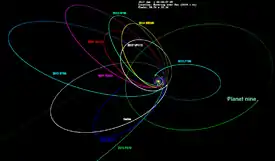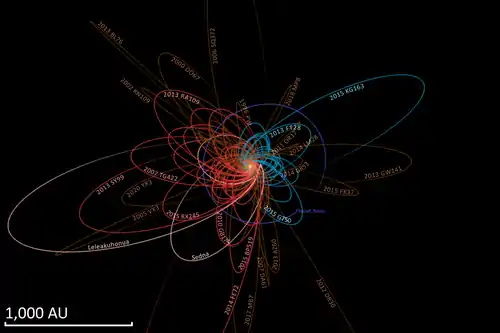(474640) 2004 VN112
(474640) 2004 VN112 is a detached object[3] (because its perihelion is greater than 40 AU). It was discovered on November 6, 2004 at Cerro Tololo. It never gets closer than 47 AU from the Sun (near the outer edge of the main Kuiper belt) and averages more than 300 AU from the Sun. Its large eccentricity strongly suggests that it was gravitationally scattered onto its current orbit. Because it is, like all detached objects, outside the current gravitational influence of Neptune, how it came to have this orbit cannot yet be explained.
| Discovery [1] | |
|---|---|
| Discovered by | Cerro Tololo Obs. |
| Discovery site | Cerro Tololo Obs. |
| Discovery date | 6 November 2004 |
| Designations | |
| (474640) 2004 VN112 | |
| TNO [2] · E-SDO (detached object)[3] | |
| Orbital characteristics[3][2] | |
| Epoch 16 February 2017 (JD 2457800.5) | |
| Uncertainty parameter 0 | |
| Observation arc | 5821 days (15.94 yr) |
| Earliest precovery date | 26 September 2000 |
| Aphelion | 586 AU (87.7 Tm) (Q) 607 AU (barycentric)[4] |
| Perihelion | 47.321 AU (7.0791 Tm) (q) |
| 316 AU (47.3 Tm) (a) 327 AU (barycentric)[4] | |
| Eccentricity | 0.8505 (e) |
| 5629 yr (2056119 d) 5918 yr (barycentric)[4] | |
| 0.478° (M) | |
| 0° 0m 0.63s /day (n) | |
| Inclination | 25.5848° (i) |
| 65.9893° (Ω) | |
| 327.061° (ω) | |
| Physical characteristics | |
| Dimensions | 314 km (based on expected albedo)[5] 130–300 km[2][6] |
| 0.04 (expected)[5] | |
| Blue[5][7] | |
| 23.3[8] | |
| 6.4[2] | |
Discovery, orbit, and physical properties

(474640) 2004 VN112 was discovered by the ESSENCE supernova survey on November 6, 2004 observing with the 4 m Blanco Telescope from Cerro Tololo Inter-American Observatory.[9][1] Its orbit is characterized by high eccentricity (0.850), moderate inclination (25.58º) and a semi-major axis of 316 AU.[1] Upon discovery, it was classified as a trans-Neptunian object. Its orbit is well determined; as of January 11, 2017 its orbital solution is based on 34 observations spanning a data-arc of 5821 days.[2] (474640) 2004 VN112 has an absolute magnitude of 6.5 which gives a characteristic diameter of 130 to 300 km for an assumed albedo in the range 0.25–0.05.[6]
Precovery images have been found back to September 26, 2000.[2]
Michael Brown's website lists it as a possible dwarf planet with a diameter of 314 kilometres (195 mi) based on an assumed albedo of 0.04.[5] The albedo is expected to be low because the object has a blue (neutral) color.[5] However, if the albedo is higher, the object could easily be half that size.
2004 VN112 was observed by the Hubble Space Telescope in November 2008 and found not to have any detectable companions.[1] It reached perihelion (closest approach to the Sun) in 2009[2] and is currently 47.7 AU from the Sun.[8] It will be in the constellation of Cetus until 2019. It comes to opposition at the start of November.
2004 VN112's orbit is similar to that of 2013 RF98, indicating that they may have both been thrown onto the orbit by the same body, or that they may have been the same object (single or binary) at one point.[7][10]
2004 VN112's visible spectrum is very different from that of 90377 Sedna.[7][11] The value of its spectral slope suggests that the surface of this object can have pure methane ices (like in the case of Pluto) and highly processed carbons, including some amorphous silicates.[7] Its spectral slope is similar to that of 2013 RF98.[7]
Relevance to the Planet Nine Hypothesis
This minor planet is one of a number of objects discovered in the Solar System to have a semi-major axis > 150 AU, a perihelion beyond Neptune, and an argument of perihelion of 340 ± 55°.[12] Of these, only eight, including 2004 VN112, have perihelia beyond Neptune's current influence.
Comparison

References
- "(474640) 2004 VN112 Orbit". IAU Minor Planet Center. Retrieved 18 November 2016.
- "JPL Small-Body Database Browser: (2004 VN112)". Retrieved 30 March 2016.
- Marc W. Buie (2007-11-08). "Orbit Fit and Astrometric record for 04VN112". SwRI (Space Science Department). Archived from the original on 2010-08-18. Retrieved 2008-07-17.
- Horizons output. "Barycentric Osculating Orbital Elements for 2004 VN112". Retrieved 2016-01-23. (Ephemeris Type:Elements and Center:@0)
- Michael E. Brown. "How many dwarf planets are there in the outer solar system? (updates daily)". California Institute of Technology. Retrieved 18 September 2016.
- "ABSOLUTE MAGNITUDE (H)". NASA/JPL. Retrieved 2008-02-28.
- de León, Julia; de la Fuente Marcos, Carlos; de la Fuente Marcos, Raúl (May 2017). "Visible spectra of (474640) 2004 VN112-2013 RF98 with OSIRIS at the 10.4 m GTC: evidence for binary dissociation near aphelion among the extreme trans-Neptunian objects". Monthly Notices of the Royal Astronomical Society: Letters. 467 (1): L66–L70. arXiv:1701.02534. Bibcode:2017MNRAS.467L..66D. doi:10.1093/mnrasl/slx003. S2CID 119419889.
- "AstDyS 2004 VN112 Ephemerides". Department of Mathematics, University of Pisa, Italy. Retrieved 2014-03-28.
- Discovery MPEC
- de la Fuente Marcos, C.; de la Fuente Marcos, R.; Aarseth, S. J. (1 November 2017). "Binary stripping as a plausible origin of correlated pairs of extreme trans-Neptunian objects". Astrophysics and Space Science. 362 (11): 198 (18pp.). arXiv:1709.06813. Bibcode:2017Ap&SS.362..198D. doi:10.1007/s10509-017-3181-1. S2CID 118890903.
- "JPL Small-Body Database Browser: 90377 Sedna (2003 VB12)". Retrieved 2014-03-28.
- "JPL Small-Body Database Search Engine: a > 150 (AU) and q > 30 (AU) and data-arc span > 365 (d)". JPL Solar System Dynamics. Retrieved 2014-04-09.